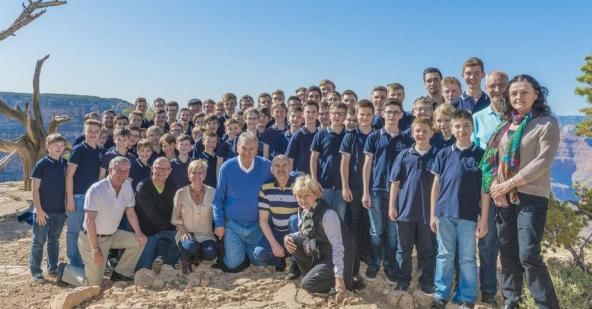 One of Tempe’s nine sister cities is Regensburg, Germany, at the confluence of the Danube and Regen rivers in Bavaria. And one of the prides of Regensburg—along with having Tempe, Ariz., for a sister city—is the Regensburger Domspatzen, the boys choir of Regensburg Cathedral.
One of Tempe’s nine sister cities is Regensburg, Germany, at the confluence of the Danube and Regen rivers in Bavaria. And one of the prides of Regensburg—along with having Tempe, Ariz., for a sister city—is the Regensburger Domspatzen, the boys choir of Regensburg Cathedral.
The boys of the Domspatzen could perhaps be considered nephews of Tempe, and in April their American relatives got to babysit them for a few eventful days—and let them sing for their keep. One of the oldest and most respected boys choirs in Europe, the Domspatzen (“Cathedral sparrows”) traces its lineage back to 975 A.D.
— more than 500 years before the first European would lay eyes on the Grand Canyon.
Almost another 500 years after that, the boys from Regensburg visited the canyon and released their angelic tones into its vast chasm. It was a moment when geological glory met musical glory.
Just hours after an evening performance at Tempe Center for the Arts, the Domspatzen choir rolled north out of Tempe before dawn in a double- decker tour bus and arrived a few hours later in Williams, then boarded the Grand Canyon Railroad for the remaining leg of the trip to the canyon.
It was aboard this handsome old train that they again broke into song: For the benefit of the conductors, they performed a spine-tingling rendition of “The Lion Sleeps Tonight.”
After they finished, Angie Thornton of Tempe Sister Cities remarked:
“Every time they impromptu sing, I just want them to keep singing.” She wasn’t disappointed by the rest of the day.
After a quick buffet lunch at Grand Canyon Village, the Domspatzen performed a concert at Shrine of the Ages, a multi-use, multi-denominational chapel not far from the South Rim.
Their set was a mix of devotional and secular works ranging from “Amazing Grace” to selections by Mozart, Mendelssohn and Brahms—the encore was a sublime version of his famous “Lullaby.” There was more texture and variety to this music than one might expect—while the upper-register voices of the younger boys are ethereal, they are undergirded and given substance by a surprisingly potent rumble of bass from the older boys.
But having finished this short indoor program, they weren’t done singing. The Domspatzen boys, along with the mayor of Regensburg, the Cathedral’s priest and other dignitaries, both German and American, next made the short hike to the rim. Although I’ve lived in Arizona for more than 20 years, I, like (probably all of) the boys, was among those seeing the canyon up close for the first time, confronted with the overwhelming, word-beggaring beauty—and dizzying cosmic vertigo—of the view, on a flawless, cloudless late April afternoon.
The commonplace about the canyon is that no photo or film can do it justice. This certainly proved true for me. The sight was majestic and moving, although my own fear of heights also made it unnerving, and the presence of a bunch of tussling, roughhousing German boys next to a drop of several thousand feet didn’t ease this anxiety.
The lads were persuaded to sing a couple more times along the trail, their dulcet sound floating down among the craggy impressionist sculptures carved by the Colorado River. Just as the canyon can’t be done justice in photos, I doubt that the exquisite quality of the Domspatzen’s music could be captured by a recording.
The surprised visitors present that day were lucky indeed.
At lunch, one of the boys, Max, explained how the choir works. It’s connected both to the Cathedral, for whom it provides music, and to a “gymnasium” (high school).
“There are some very nice traditional songs,” said Max, 17. “But many love the modern music more because it’s…” He searches for the right word, can’t find it, so he snaps his fingers a few times in a jazzy beat.
“We love the modern stuff.”
Max has been with the choir since he was nine. One could theoretically be a member until the age of 20, though it would mean failing one’s graduation exams two years in a row.
This seems unlikely in Max’s case. Asked what he’d like to do for a career, he says “Something technical, because my language…” he shrugs apologetically. “There are others better than me.”
He says this in better-enunciated English than one expects from the average American 17-year-old. After some souvenir shopping, the party was herded back onto the bus and driven to a dinner of fajitas at the Weatherford Hotel in downtown Flagstaff, then back down I-17 to the Valley, rolling into the parking lot of Tempe Public Library well after midnight.
It was seriously exhausted boys that stumbled off the bus to their waiting host families.
But they had been given lifelong memories that day, and with their music they had created some lifelong memories for all of us, too.
Note: Reprinted from the Wrangler News. Contributor M.V. Moorhead and photographer Billy Hardiman accompanied members of the famed, centuries-old boys choir from Germany during their Sister Cities outing to the Grand Canyon.

